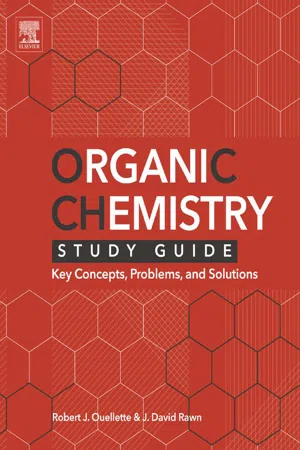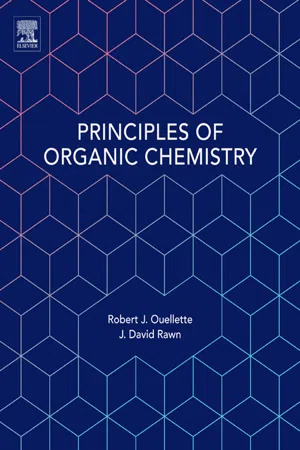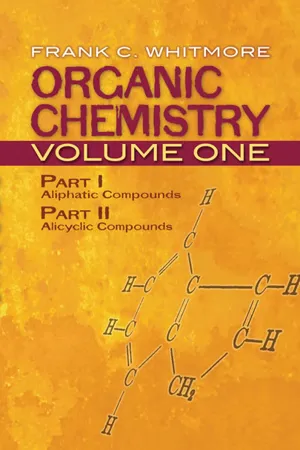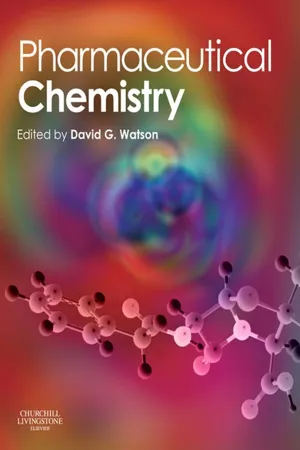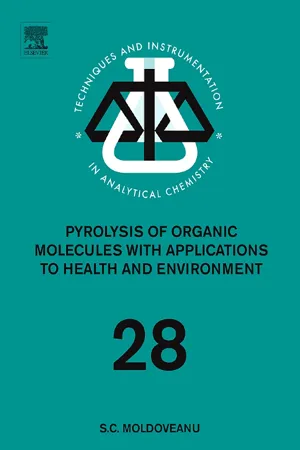Chemistry
Amine Classification
Amine classification is the process of categorizing amines based on the number of alkyl or aryl groups attached to the nitrogen atom. Amines can be classified as primary, secondary, or tertiary depending on the number of groups attached to the nitrogen atom. This classification is important in understanding the reactivity and properties of amines.
Written by Perlego with AI-assistance
Related key terms
Related key terms
1 of 4
Related key terms
1 of 3
5 Key excerpts on "Amine Classification"
- eBook - ePub
Organic Chemistry Study Guide
Key Concepts, Problems, and Solutions
- Robert J. Ouellette, J. David Rawn(Authors)
- 2014(Publication Date)
- Elsevier(Publisher)
Amines are classified according to the number of alkyl or aryl groups bonded to the nitrogen atom. Primary, secondary, and tertiary amines have 1, 2, and 3 groups bonded, respectively. Amides are classified the same way, with the acyl group counting as one of the carbon groups bonded to the nitrogen atom. Abbreviations for the classes of amines and amides are 1°, 2°, and 3°.The common names of simple amines are based on the identity of the alkyl or aryl groups bonded to the nitrogen atom. The names of the alkyl groups are written in alphabetical sequence as one word, followed by the word amine.The common name of a complex amine is based first on identifying the longest continuous chain containing an attached nitrogen atom. The chain is numbered to assign the lowest number to the carbon atom bonded to the nitrogen atom. The nitrogen atom may be contained in an amino group (—NH2 ), an N -alkylamino group (—NHR), or an N ,N -dialkylamino group (—NR2 ). Aryl groups may be present in place of alkyl groups, and the same procedure is followed. In naming alkylamino or arylamino groups, the prefix N -indicates that the alkyl or aryl group is attached to the nitrogen atom, and not to the parent chain.The IUPAC name of an amine is also based on the longest continuous chain containing an attached nitrogen atom. The -e ending of the parent alkane is changed to -amine. The chain is numbered to give the lowest number to the carbon atom bearing the nitrogen atom. Alkyl groups attached to nitrogen are designated with N -, but they are named along with other substituents on the parent chain.Heterocyclic aromatic amines have rings that are numbered using a selected nitrogen atom as the number one atom. The Chemical Abstract System (CAS) of heterocyclic ring nomenclature has been accepted by the IUPAC. We use CAS names in this text.23.4 Physical Properties of Amines
Amines may be gases, liquids, or solids depending on their molecular weight and structure. The boiling points of primary and secondary amines are higher than those for alkanes of similar molecular weight because these amines form intermolecular hydrogen bonds. Tertiary amines have lower boiling points than isomeric primary and secondary amines because tertiary amines do not have an N—H bond to form intermolecular hydrogen bonds. The lower molecular weight amines are soluble in water as a result of hydrogen bonding to water molecules. - eBook - ePub
- Robert J. Ouellette, J. David Rawn(Authors)
- 2015(Publication Date)
- Elsevier(Publisher)
3 hybrid orbitals. As expected from VSEPR theory, these orbitals point to the corners of a tetrahedron. Three are half-filled. They form three covalent bonds. The fourth orbital contains a pair of nonbonded electrons.12.3 Structure and Classification of Amines and Amides
In the simplest amine, methylamine (CH3 NH2 ), one hydrogen atom of ammonia has been replaced by a methyl group (Figure 12.2 ). The nitrogen atom of methylamine and other amines has five valence electrons in four sp3 hybrid orbitals that are directed to the corners of a tetrahedron. Three of these orbitals are half-filled; the fourth contains a nonbonding pair of electrons that plays an important role in the chemical properties of amines.Figure 12.2 Structure of MethylamineAmines are classified by the number of alkyl (or aryl) groups attached to the nitrogen atom. Note that amines are not classified like alcohols. (The classification of alcohols is based on the number of groups attached to the carbon atom bearing the hydroxyl group.) For example, tert -butylamine has a tert -butyl group attached to an –NH2 group. However, the amine is primary because only one alkyl group is bonded to the nitrogen atom. In contrast, tert -butyl alcohol is a tertiary alcohol because the carbon atom bonded to the –OH group is bonded to three alkyl groups. Trimethylamine is a tertiary amine because the nitrogen atom is bonded to three alkyl groups.The nitrogen atom of an amine may be contained in a ring, a common feature of nitrogen compounds in nature. The simplest five- and six-membered nitrogen-containing heterocyclic compounds are pyrrolidine and piperidine.Problem 12.2 Classify the nitrogen-containing functional groups in Mepivacaine®, a local anesthetic.Amides have an amino group or a substituted amino group bonded to a carbonyl carbon atom. The other two bonds of the nitrogen atom may be to hydrogen atoms, alkyl groups, or aryl groups. Amides are classified based on the number of carbon groups (including the acyl group) bonded to the nitrogen atom. - eBook - ePub
Organic Chemistry, Volume One
Part I: Aliphatic Compounds Part II: Alicyclic Compounds
- Frank C. Whitmore(Author)
- 2012(Publication Date)
- Dover Publications(Publisher)
VIII. AMINES, ALKYL DERIVATIVES OF AMMONIADepending on the number of H atoms replaced in NH3 , the amines are primary, secondary and tertiary, RNH2 (amino group, −NH2 ), RR´NH (imino group, =NH), and RR′R′′N respectively. They have the basic properties of ammonia but form more strongly basic solutions probably because of the greater stability of their “hydrates” as compared with that of ammonia. The primary and secondary amines are “alcohols of the ammonia system”730 , while the tertiary amines are “ethers” on the same basis. The lower amines have characteristic odors somewhat resembling that of NH3 . The three methylamines and primary ethylamine boil below 20°. The others are liquids with boiling points increasing with their molecular weights to heptadecylamine at 340° and tri-n -octylamine at 366°. Branching lowers the boiling points as in the alcohols. This is shown by the following isomeric (metameric) amines: Et3 N, 90°; Pr2 NH, 110°; HexNH2 , 129°. The densities of the amines range from 0.66 to 0.77.The preparations and reactions of the amines can be more safely generalized than can those of the alcohols. There are few reactions of amines in which the C−N linkage is broken whereas most reactions of alcohols involve the breaking of the C−O linkage. The outstanding example of the breaking of a C−N linkage, the action of nitrous acid with a primary amine, presents even more irregularities than any alcohol reaction (p. 172).The amines unite with HX in the same way that NH3 does, forming salts such as NH4 Cl, RNH3 Cl, R2 NH2 Cl, R3 NHCl, etc. The substituted ammonium salts (amine hydrochlorides etc.) have much the same properties as the parent substance. They are very soluble crystalline compounds. They are more soluble in organic liquids than the simple ammonium salts. Ammonia and the amines add certain alkyl halides to give ammonium salts having one more alkyl group than the starting material. The last possible stage is a quaternary ammonium compound R4 NX. The corresponding hydroxides RNH3 OH, R2 NH2 OH, R3 NHOH, R4 NOH, act as stronger bases than the parent ammonium hydroxide probably because of their greater stability. Me4 NOH can be obtained as a solid resembling KOH in physical and chemical properties. On heating, however, it decomposes giving Me3 N and MeOH. Secondary amines give stronger bases than either the corresponding primary or tertiary amines.731 - eBook - ePub
- David G. Watson(Author)
- 2011(Publication Date)
- Churchill Livingstone(Publisher)
Chapter 3 Amines David G. Watson Chapter contents Introduction 35 Factors affecting the p Ka value of a base 36 Alkyl groups 36 Electron withdrawing groups 39 Salt formation 48 Reactions of amines in relation to storage and formulation 48 Oxidation 48 Acylation 48 Schiff’s base formation 49 Quaternary amines 52 Introduction The amine group can be considered as the single most important group for conferring pharmacological activity. This is because it is the principle group within organic molecules that bears a positive charge. When it is present in a drug molecule it can exert biological effects through electrostatic interactions with negatively charged groups within proteins and also compete with positively charged cations such as sodium, potassium and calcium ions in biological processes. Amines are derived from ammonia and have the structures shown in Figure 3.1 for mono-, di- and trisubstituted nitrogen. Figure 3.1 Amines. The structures may look planar but, in fact, the structures of amines are more or less tetrahedral, like tetrasubstituted carbon, as shown for trimethylamine in Figure 3.2. In the case of nitrogen, the position that would be occupied by a fourth bond in tetrasubstituted carbon is occupied by a lone pair of electrons. Since nitrogen is less electronegative than oxygen the lone pair within an amine structure is more available than the lone pairs on an oxygen atom to interact with a proton. An approximate measure of the availability of lone pairs of electrons is given by the energy of the highest occupied molecular orbital (HOMO). The deeper the ‘energy well’ that the molecular orbital occupies the less available the electrons are for bond formation with a proton. Thus water has a HOMO of −12.5 eV while ammonia has a HOMO of −10.5 eV, and thus its electrons are more available and it protonates more readily than water - eBook - ePub
Pyrolysis of Organic Molecules
Applications to Health and Environmental Issues
- Serban C. Moldoveanu(Author)
- 2009(Publication Date)
- Elsevier Science(Publisher)
hapter 13 Pyrolysis of Amines and IminesS.C. Moldoveanu
13.1. Primary amines
General aspects
Primary amines can be considered as compounds derived from ammonia by the substitution of a hydrogen atom with an organic radical alkyl or aryl, or as compounds resulting from the substitution of a hydrogen atom from an organic molecule with the group NH2 . The general formula of primary amines is R–NH2 (for aromatic primary amines the formula Ar–NH2 is sometimes used). Continuing the substitution of hydrogens from ammonia with alkyl or aryl organic radicals, secondary amines (R2 NH) and tertiary amines (R3 N) are generated. The formation of quaternary ammonium cations ( ) is also possible, these compounds being the equivalent of ion having the hydrogen substituted with organic radicals. The amines are named either using the name of the organic radical with the suffix amine (e.g., methylamine for CH3 –NH2 ) or using the prefix amino followed by the name of the hydrocarbon (e.g., aminomethane for CH3 –NH2 ). The substitution of a hydrogen from ammonia with an acyl radical (R–C(O)–) leads to the formation of amides. Amides can be considered derivatives of acids, and their pyrolysis is discussed in Chapter 20. Amine oxides can also be considered compounds different from amines and are discussed in Section 14.4.Aliphatic primary amines
Aliphatic primary amines have a carbon with sp3 hybridization and two hydrogen atoms connected to the nitrogen atom. Pyrolysis of these compounds can take place with the involvement of the NH2 group. In this case, there are two common paths, one with ammonia elimination and formation of an unsaturated hydrocarbon (similar to water elimination in alcohols) and the other with hydrogen elimination and formation of a nitrile. These two types of reactions are shown below:(13.1.1) (13.1.2) Other reactions involving the amino group were also noticed during pyrolysis of some amines, such as generation of HCN, N2
Index pages curate the most relevant extracts from our library of academic textbooks. They’ve been created using an in-house natural language model (NLM), each adding context and meaning to key research topics.
Explore more topic indexes
Explore more topic indexes
1 of 6
Explore more topic indexes
1 of 4
